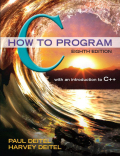
(Quicksort) In the examples and exercises of Chapter 6 and this appendix, we discussed various sorting techniques. We now present the recursive sorting technique called Quicksort. The basic
- Partitioning Step: Take the first element of the unsorted array and determine its final location in the sorted array (i.e., all values to the left of the element in the array are less than the element, and all values to the right of the element in the array are greater than the element). We now have one element in its proper location and two unsorted subarrays.
- Recursive Step: Perform Step a on each unsorted subarray.
Each time Step a is performed on a subarray, another element is placed in its final location of the sorted array, and two unsorted subarrays are created. When a subarray consists of one element, it must be sorted; therefore, that element is in its final location.
The basic algorithm seems simple enough, but how do we determine the final position of the first element of each subarray? As an example? Consider the following set of values (the element in bold is the partitioning element—it will be placed in its final location in the sorted array):

- Starting from the rightmost element of the array, compare each element with 37 until an element less than 37 is found. Then swap 37 and that element. The first element less than 37 is 12, so 37 and are swapped. The new array is
- Element 12 is in italic to indicate that it was just swapped with 37.
- Starting from the left of the array, but beginning with the element after 12, compare each element with 37 until an element greater than 37 is found. Then swap 37 and that element. The first element greater than 37 is 89, so 37 and 89 are swapped. The new array is
- Starting from the right, but beginning with the element before 89, compare each element with 37 until an element less than 37 is found. Then swap 37 and that element. The first element less than 37 is 10, so 37 and 10 are swapped. The new array is
- Starting from the left, but beginning with the element after 10, compare each element with 37 until an element greater than 37 is found. Then swap 37 and that element. There are no more elements greater than 37, so when we compare 37 with itself, we know that 37 has been placed in its final location in the sorted array.



Once the partition has been applied to the array, there are two unsorted subarrays. The subarray with values less than 37 contains 12, 2, 6, 4, 10 and s. The subarray with values greater than 37 contains 89, 63 and 45. The sort continues by partitioning both subarrays in the same manner as the original array.
Write recursive function quicksort to sort a one-dimensional integer array. The function should receive as arguments an integer array, a starting subscript and an ending subscript. Function partition should be called by quicksort to perform the partitioning step.
Trending nowThis is a popular solution!

Additional Engineering Textbook Solutions
Java How to Program, Early Objects (11th Edition) (Deitel: How to Program)
Computer Science: An Overview (13th Edition) (What's New in Computer Science)
SURVEY OF OPERATING SYSTEMS
Elementary Surveying: An Introduction To Geomatics (15th Edition)
Starting Out with Java: From Control Structures through Data Structures (4th Edition) (What's New in Computer Science)
- Please solve and answer the questions correctly please. Thank you!!arrow_forwardConsidering the TM example of binary sum ( see attached)do the step-by-step of execution for the binary numbers 1101 and 11. Feel free to use the Formal Language Editor Tool to execute it; Write it down the current state of the tape (including the head position) and indicate the current state of the TM at each step.arrow_forwardI need help on inculding additonal code where I can can do the opposite code of MatLab, where the function of t that I enter becomes the result of F(t), in other words, turning the time-domain f(t) into the frequency-domain function F(s):arrow_forward
 C++ for Engineers and ScientistsComputer ScienceISBN:9781133187844Author:Bronson, Gary J.Publisher:Course Technology Ptr
C++ for Engineers and ScientistsComputer ScienceISBN:9781133187844Author:Bronson, Gary J.Publisher:Course Technology Ptr C++ Programming: From Problem Analysis to Program...Computer ScienceISBN:9781337102087Author:D. S. MalikPublisher:Cengage LearningProgramming Logic & Design ComprehensiveComputer ScienceISBN:9781337669405Author:FARRELLPublisher:Cengage
C++ Programming: From Problem Analysis to Program...Computer ScienceISBN:9781337102087Author:D. S. MalikPublisher:Cengage LearningProgramming Logic & Design ComprehensiveComputer ScienceISBN:9781337669405Author:FARRELLPublisher:Cengage Microsoft Visual C#Computer ScienceISBN:9781337102100Author:Joyce, Farrell.Publisher:Cengage Learning,
Microsoft Visual C#Computer ScienceISBN:9781337102100Author:Joyce, Farrell.Publisher:Cengage Learning, New Perspectives on HTML5, CSS3, and JavaScriptComputer ScienceISBN:9781305503922Author:Patrick M. CareyPublisher:Cengage Learning
New Perspectives on HTML5, CSS3, and JavaScriptComputer ScienceISBN:9781305503922Author:Patrick M. CareyPublisher:Cengage Learning Programming with Microsoft Visual Basic 2017Computer ScienceISBN:9781337102124Author:Diane ZakPublisher:Cengage Learning
Programming with Microsoft Visual Basic 2017Computer ScienceISBN:9781337102124Author:Diane ZakPublisher:Cengage Learning





